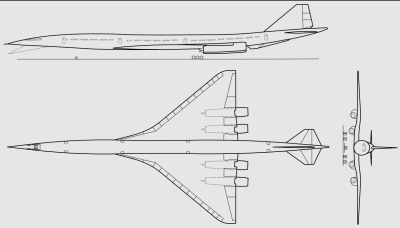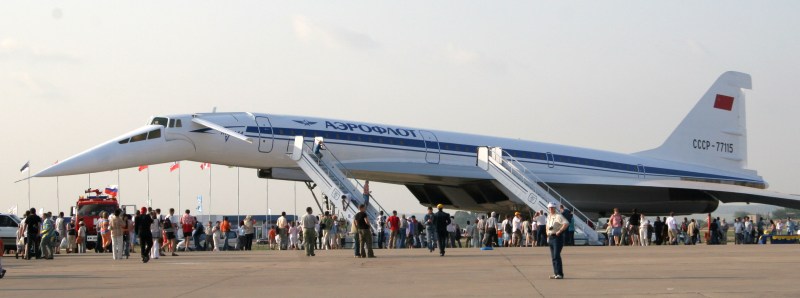Although spying is a time-honored tradition, the sheer scope of it reached a fever pitch during the Cold War, when everyone was spying on everyone, and conceivably for both sides at the same time. In an era where both McCarthyism and the character of James Bond enjoyed strong popularity, it should come as no surprise that a project of geopolitical importance like the development of the world’s first supersonic airliner would come amidst espionage, as well as accusations thereof.
This is the topic of a documentary that recently aired on Channel 4 in the UK called Concorde: The Race for Supersonic, yet what is the evidence that the Soviet Tu-144 truly was just a Concorde clone, a derogatory nicknamed ‘Concordski’?

At the time that the Concorde was being developed, there wasn’t just the competition from the Tu-144 team, but also the Boeing 2702 (pictured) and Lockheed L-2000, with the latter two ultimately being cancelled. Throughout development, all teams converged on a similar design, with a delta wing and similar overall shape. Differences included the drooping nose (absent on Boeing 2707-300) and use of canards (present on Tu-144 and 2707-200), and wildly different engines, with the production Tu-144S requiring an afterburner on its Kuznetsov NK-144A engines just like the Concorde, before the revised Tu-144D removing the need for afterburners with the Koliesov RD36-51 engines.
Although generally classified as a ‘failure’, the Tu-144’s biggest issues appear to have been due to the pressure on the development team from Soviet leadership. Once the biggest issues were being fixed (Tu-144D) it saw continued use for cargo use and even flying missions for NASA (Tu-144LL) until 1999. Although Soviet spies were definitely caught with Concorde blueprints, the practical use of these for the already overburdened Tu-144 development team in terms of reverse-engineering and applying it to the Tu-144’s design would be limited at best, which would seem to be reflected in the final results.
Meanwhile, although supersonic airliners haven’t been flying since the Concorde retired in 2003, the Lockheed Martin X-59 Quesst supersonic airplane that is being built for NASA looks set to fix the sonic boom and fuel usage issues that hampered supersonic flight. After the L-2000 lost to Boeing so many decades ago, it might be Lockheed that has the last laugh in the race towards supersonic flight for airliners.
Top image: Tu-144 with distinctive droop nose at the MAKS-2007 exhibition)
















McCarthy was correct in his accusations.
Well yeah, stopped clock and all that.
Pyotr Ufimtsev – father of stealth aircraft technology.
An example of at least a trillion dollars given away, no espionage required.
The US government spies more on US citizens today that Russians did back then. Ed Snowden should not be in exile for telling this truth.
NSA got caught … multiple times in botched spying.
In the case of the spy sting on Iran malware offense use
caused author of A Pretext for War to engineer informing
the Iranians what happened.
“NSA, Crypto AG, and the Iraq-Iran Conflict.”
https://www.hermetic.ch/crypto/kalliste/speccoll.htm
“with the latter two ultimately being cancelled”
A wise move considering the degree of commercial success of their competitors and a rare occasion where technological national prestige seeking behavior fell to practical considerations.
“After the L-2000 lost to Boeing so many decades ago, it might be Lockheed that has the last laugh in the race towards supersonic flight for airliners.”
Espionage live and well, till those plans get spirited away.
“the Boeing 2702 (pictured)”
…in the picture that says 2707-300?
“the drooping nose (absent on Boeing 2707-300)”
There’s a dotted line in that image that bears a suspicious resemblance to a drooping nose…
I’m surprised they didn’t install video cameras and monitors (or even just an optical periscope) to give the pilots a better view of the runway. Even with the limited technology of the time, I would expect it to be lighter and more reliable than the mechanism to lower the nose.
I’m sure they did consider it, but remember that the prototypes were built in 1965. TV cameras then were still pretty primitive then (the BBC didn’t start broadcasting in colour until 1967).
I actually got to step inside a 2707 at Hiller Air Museum in California. Amazing plane. The nose did droop btw: https://youtu.be/I7RUDDb1UA8
One story going around about the TU-144 is that the Russians wanted technical help and went to BAC-Aerospatiale who were willing to help. But then the governments stepped in (UK and French I would imagine but no doubt with pressure in the background from the US) to block the assistance because of fears the tech would end up in military applications.